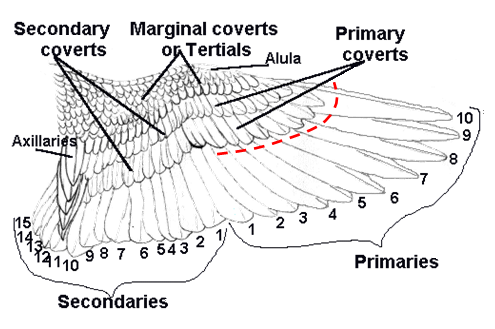Nail Trimming
Small Bird
(Parakeets, Love Birds, Parotletts, etc.)
Medium Bird
(Cockatiels, Conures, Senegals, etc.)
Large Bird
(Amazons, African Grays, Macaws, etc.)
Small Mammal
(Rabbits and Guinea Pigs)
Reptile
(Bearded Dragons, Iguanas, etc.)
Wing Trimming
Small Bird
(Parakeets, Love Birds, Parotletts, etc.)
Medium Bird
(Cockatiels, Conures, Senegals, etc.)
Large Bird
(Amazons, African Grays, Macaws, etc.)
Wing & Nail Trimming Combo
Small Bird
(Parakeets, Love Birds, Parotletts, etc.)
Medium Bird
(Cockatiels, Conures, Senegals, etc.)
Large Bird
(Amazons, African Grays, Macaws, etc.)
Pet World follows the guidance of the American Veterinary Medical Association with regard to trimming the wings of domestic, pet birds. Generally, we trim the outer eight Primary flight feathers of each wing (#3-10) unless otherwise requested.
The following points should be considered when deciding to trim a bird's feathers.
 1. Type of Flier. Small bodied, lightweight birds who fly easily may need all ten primaries trimmed to prevent flying. We suggest starting with the outer eight. Cockatiels, conures, & small parrots generally need the outer eight. Large parrots who fly well need the outer six to eight. Large parrots who are not strong fliers probably only need the outer four to six trimmed. The idea is to prevent them from flying away (as opposed to not flying at all). Limited distance flying and soft landings are the goal.
1. Type of Flier. Small bodied, lightweight birds who fly easily may need all ten primaries trimmed to prevent flying. We suggest starting with the outer eight. Cockatiels, conures, & small parrots generally need the outer eight. Large parrots who fly well need the outer six to eight. Large parrots who are not strong fliers probably only need the outer four to six trimmed. The idea is to prevent them from flying away (as opposed to not flying at all). Limited distance flying and soft landings are the goal.
2. Risk Assessment. Consider safety needs based on the bird’s situation. Are there cats and dogs in the home? Large windows? Are doors left open? Does the bird fly often? How much time is spent out of the cage? Does the bird fo outside? Wings are clipped in order to prevent a domestic, pet bird from flying into glass or flying away. However, some lift should still be possible in order to provide a soft, safe landing.
A bird's wings should only be clipped for their own safety. For example, wild birds should never be clipped (unless they injured and rehabilitating). They need to remain fully flighted. Pet birds, however, are at increased risk when they are fully flighted. Shortened primary feathers decrease the risk of damage while stretching and flapping inside the cage. Even in a large cage a bird can get its feathers caught if perched too close to the side of the cage. Regardless of temperament, training level, or past history, pet birds should only be allowed outside with clipped wings or while wearing a suitable harness. Something could startle the bird, causing it to fly away, and domesticated pet birds are simply not prepared to survive in the wild. A bird with a risk free lifestyle, however, does not need to be clipped.
Some bird owners still prefer to leave a few primaries (usually the outer two, #9-10) for aesthetics. Even though this looks more natural, Pet World agrees with the AVMA and discourages this practice because the possibility of unexpected lift puts those two feathers at risk for being broken upon a crash landing. Remember, the goal is to limit flight to a safe, manageable distance -- not prevent flight entirely. Furthermore, those two primaries sticking out are at risk of getting caught and broken in between the cage bars.
Many years ago the general practice was to only trim one side, alternating wings each time the feathers grew back. With the possible risk of improperly balanced muscle development, and the stress risk of partially flying in small circles, Pet World believes trimming both wings symmetrically makes the most sense and is safest for the bird.
While it is true that primary feathers are like hair in some ways (it doesn't hurt when cut), they do not grow continually like hair. Feathers are shed and replaced according to a bird’s molting cycle. If a wing trim occurs soon after new feathers reach their maximum length, that trim may last for several months. If the primary feathers are several months old, the trimmed feathers may fall out and start to grow back a week later with the next molt.
Pet World has been expertly trimming wings since 1988.
Please feel free to come in and discuss your bird's needs with a Pet World technician anytime!




